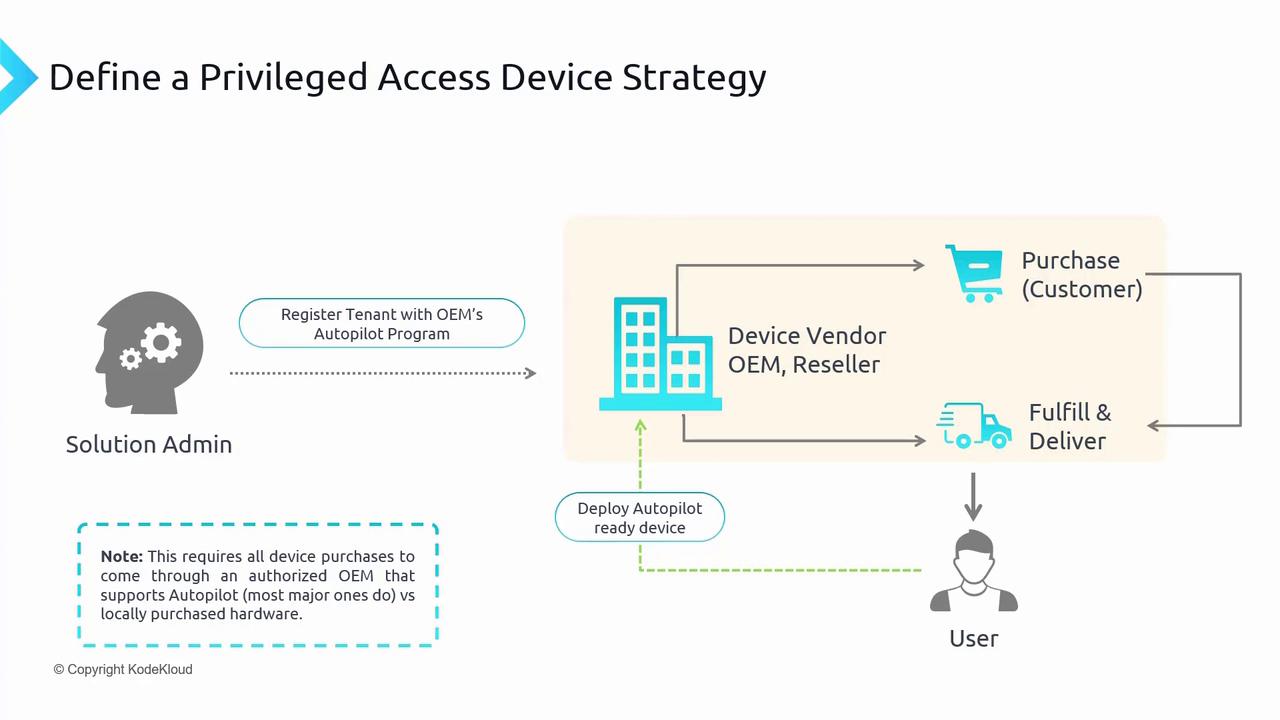Microsoft Azure Security Technologies (AZ-500)
Host Security
Define a privileged access device strategy
A privileged access device strategy establishes a robust process for managing the devices that handle an organization’s most sensitive tasks. These devices serve as a critical line of defense, ensuring that high-level administrative operations are executed securely.
Consider a financial institution where daily sensitive transactions demand strict access control. In such environments, administrators require elevated privileges to manage transactions and safeguard the integrity of financial data. Implementing a structured privileged access device strategy in Azure allows the institution to designate specific devices solely for these critical tasks.
In the first phase, a solution administrator registers the institution’s tenants with an OEM Autopilot program, initiating the device procurement process. Once registered, the hardware vendor fulfills the device order, ensuring that the devices are delivered ready for deployment. These autopilot-ready devices are pre-configured with essential security controls to manage sensitive transactions securely.
As illustrated in the diagram below, deploying a privileged access device strategy from the outset significantly minimizes the risk of unauthorized access and data breaches:

By leveraging Azure Privileged Identity Management, organizations can create a controlled environment for high-level administrative tasks, thus enhancing their overall security posture.
Establishing a Hardware Root of Trust
To build a secure digital workstation, establishing a hardware root of trust is essential. This concept revolves around designating a trusted workstation as the foundation of your supply chain security solution. Modern laptops equipped with key security technologies can effectively serve as the hardware root of trust.
Here are the essential technologies that contribute to a secure hardware root of trust:
Trusted Platform Module (TPM) 2.0
TPM 2.0 enables hardware-based security by securely generating cryptographic keys and providing robust identity and integrity checks.BitLocker Encryption
BitLocker offers full-volume encryption, protecting data even if the drive is removed, ensuring unauthorized users cannot access the data without the proper decryption key.UEFI Secure Boot
This feature verifies that only trusted software from the manufacturer is loaded during boot, effectively reducing risks from boot kits and rootkits.Drivers and Firmware via Windows Update
Distributing drivers and firmware through Windows Update ensures systems receive timely security patches, mitigating vulnerabilities.Virtualization and Hypervisor-Protected Code Integrity (HVCI)
Enabling virtualization and HVCI allows the system to run code in a secure, isolated environment, which is crucial for defending against malware and other malicious software.HVCI-Ready Drivers and Apps
Ensuring that hardware and software are HVCI ready facilitates smooth virtualization and maintains secure system performance.Windows Hello
Integrated with Azure AD Join for Devices, Windows Hello provides a secure, password-free sign-in experience using biometric verification or a PIN, enhancing authentication.DMA I/O Protection
This feature protects against unauthorized memory access, shielding the system from potential Direct Memory Access (DMA) attacks.System Guard
By leveraging both hardware and software security features, System Guard maintains robust runtime system integrity for safe operations.Modern Standby
Modern Standby improves system performance and responsiveness while ensuring that the device is always secure and ready to respond quickly.
Implementing these technologies in modern laptops creates a solid hardware root of trust, establishing a secure digital workspace dedicated to privileged access roles.
Note
Privileged access workstations refer to specialized, vendor-purchased hardware devices. Although virtual machines can be configured for privileged access, they do not offer the same level of hardware control and may impose certain restrictions. Even though TPM-enabled virtual machines (TPM VMs) in Azure provide enhanced functionality, using dedicated privileged access devices remains the recommended security practice.
With this hardware foundation in place, organizations can confidently deploy dedicated privileged access workstations, ensuring that all critical administrative tasks are executed in a secure and controlled environment.
Additional Resources
For more detailed information, refer to the following resources:
This strategy not only enhances your organization's security posture but also streamlines the management of highly sensitive operations across your digital infrastructure.
Watch Video
Watch video content